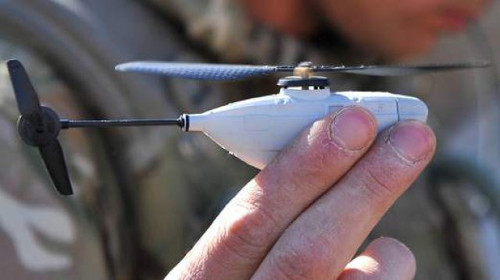 |
| August 12, 2014 | Volume 10 Issue 30 |
Designfax weekly eMagazine
Archives
Partners
Manufacturing Center
Product Spotlight
Modern Applications News
Metalworking Ideas For
Today's Job Shops
Tooling and Production
Strategies for large
metalworking plants
Engineer's Toolbox:
Army researchers developing pocket drone
By Jeffrey Sisto, NSRDEC
Researchers at the U.S. Army Natick Soldier Research, Development and Engineering Center (NSRDEC) in Natick, MA, are developing a pocket-size aerial surveillance device for Soldiers and small units operating in challenging ground environments.

A British Soldier holds Prox Dynamics' PD-100 Black Hornet, a palm-sized miniature helicopter weighing only 16 grams. Researchers with the U.S. Army Natick Soldier Research, Development and Engineering Center are testing the Black Hornet to provide squad-sized small units with organic intelligence, surveillance, and reconnaissance capability.
The Cargo Pocket Intelligence, Surveillance and Reconnaissance program, or CP-ISR, seeks to develop a mobile Soldier sensor to increase the situational awareness of dismounted Soldiers by providing real-time video surveillance of threat areas within their immediate operational environment.
While larger systems have been used to provide over-the-hill ISR capabilities on the battlefield for almost a decade, none of those delivers it directly to the squad level, where Soldiers need the ability to see around the corner or into the next room during combat missions.
When Soldiers and small units need to assess the threat in a village, or in thick canopy terrain where traditional ISR assets cannot penetrate, the CP-ISR can be deployed to provide that capability.
"The Cargo Pocket ISR is a true example of an applied systems approach for developing new Soldier capabilities," says Dr. Laurel Allender, acting NSRDEC technical director. "It provides an integrated capability for the Soldier and small unit for increased situational awareness and understanding with negligible impact on Soldier load and agility."
NSRDEC engineers investigated existing commercial off-the-shelf technologies to identify a surrogate CP-ISR system.
Prox Dynamics' PD-100 Black Hornet, a palm-sized miniature helicopter weighing only 16 grams, has the ability to fly up to 20 minutes while providing real-time video via a digital data link from one of the three embedded cameras and operates remotely with GPS navigation. Tiny, electric propellers and motors make the device virtually undetectable to subjects under surveillance.
The size, weight, and image-gathering capabilities of the system are promising advancements that fulfill the burgeoning requirement for an organic, squad-level ISR capability, but more work still needs to be done.
Several efforts are underway to develop three different aspects of the technology to ensure it is ready for the Soldier and small unit.
The first of these efforts is focused on a redesign of the digital data link to achieve compatibility with U.S. Army standards.
The second focuses on developing and integrating advanced payloads for low-light imaging, allowing for indoor and night operations.
Lastly, researchers are continuing to develop and enhance guidance, navigation, and control (or GNC) algorithms for the CP-ISR surrogate system. This will allow the airborne sensor to operate in confined and indoor spaces, such as when Soldiers advance from room to room as they are clearing buildings.
In November 2014, NSRDEC will collaborate with the Maneuver Center of Excellence, the Army Research Laboratory, and other organizations to support the Army Capabilities Integration Center's Manned Unmanned Teaming (Ground) Limited Objective Experiment, or LOE, by demonstrating the current capabilities of mobile Soldier sensors.
While the final system could be different from the surrogate system, NSRDEC is focused on proving the basic capability first.
The Natick Soldier Research, Development and Engineering Center is part of the U.S. Army Research, Development and Engineering Command, which has the mission to develop technology and engineering solutions for America's Soldiers.
Published August 2014
Rate this article
View our terms of use and privacy policy
